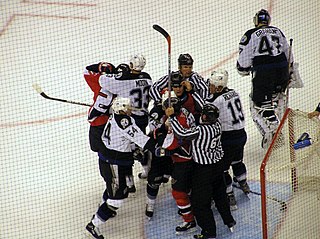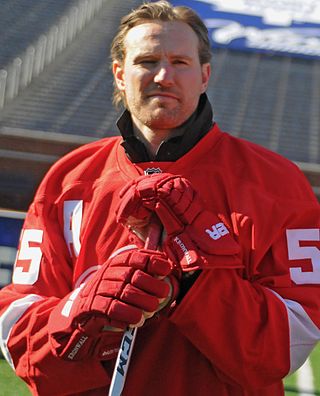
Match penalty is a term used in some sports for a player having committed such a serious offense that he or she is being sent off for the rest of the game. The term is used in bandy, [1] floorball, and ice hockey. [2]

Match penalty is a term used in some sports for a player having committed such a serious offense that he or she is being sent off for the rest of the game. The term is used in bandy, [1] floorball, and ice hockey. [2]
In bandy, it is indicated with a red penalty card. [3]
In ice hockey, there are two kinds of sending-off penalties: “game misconduct penalty” and the more serious or more extreme “match penalty” which is imposed for deliberately injuring another player as well as attempting to injure another player. Many other penalties automatically become match penalties if injuries actually occur: under NHL rules, butt-ending, goalies using blocking glove to the face of another player, head-butting, kicking, punching an unsuspecting player, spearing, and tape on hands during altercation [4] must be called as a match penalty if injuries occur. Under IIHF rules, match penalty used to be imposed for kneeing [5] and checking to the head or neck area [6] if injuries occurred; since the 2023/24 edition of IIHF rules, match penalty has been removed from the rules and a major penalty with a game misconduct penalty should be imposed for dangerous actions. [7]

Bandy is a winter sport and ball sport played by two teams wearing ice skates on a large ice surface while using sticks to direct a ball into the opposing team's goal.

Ice hockey is a team sport played on ice skates, usually on an ice skating rink with lines and markings specific to the sport. It belongs to a family of sports called hockey. In ice hockey, two opposing teams use ice hockey sticks to control, advance, and shoot a closed, vulcanized, rubber disc called a "puck" into the other team's goal. Each goal is worth one point. The team which scores the most goals is declared the winner. In a formal game, each team has six skaters on the ice at a time, barring any penalties, one of whom is the goaltender. Ice hockey is a full contact sport, and is considered to be one of the more physically demanding team sports. It is distinct from field hockey, in which players move a ball around a non-frozen pitch using field hockey sticks.

A penalty in ice hockey is a punishment for an infringement of the rules. Most penalties are enforced by sending the offending player to a penalty box for a set number of minutes. During the penalty the player may not participate in play. Penalties are called and enforced by the referee, or in some cases, the linesman. The offending team may not replace the player on the ice, leaving them short-handed as opposed to full strength. When the opposing team is said to be on a power play, they will have one more player on the ice than the short-handed team. The short-handed team is said to be "on the penalty kill" until the penalty expires and the penalized player returns to play. While standards vary somewhat between leagues, most leagues recognize several common varieties of penalties, as well as common infractions.

An ice hockey rink is an ice rink that is specifically designed for ice hockey, a competitive team sport. Alternatively it is used for other sports such as broomball, ringette, rinkball, and rink bandy. It is a rectangle with rounded corners and surrounded by walls approximately 1.22 metres (48 in) high called the boards.
Boarding in ice hockey is a penalty called when an offending player pushes, trips or checks an opposing player violently into the boards (walls) of the hockey rink.
Checking in ice hockey is any of a number of defensive techniques aimed at disrupting an opponent with possession of the puck or separating him from the puck entirely. Most types are not subject to penalty.

Fighting is an established tradition in North American ice hockey, with a long history that involves many levels of amateur and professional play and includes some notable individual fights. Fights may be fought by enforcers, or "goons" —players whose role is to fight and intimidate—on a given team, and are governed by a system of unwritten rules that players, coaches, officials, and the media refer to as "the code". Some fights are spontaneous, while others are premeditated by the participants. While officials tolerate fighting during hockey games, they impose a variety of penalties on players who engage in fights.

Violence has been a part of ice hockey since at least the early 1900s. According to the book Hockey: A People's History, in 1904 alone, four players were killed during hockey games from the frequent brawls and violent stickwork.

In sports, an ejection is the removal of a participant from a contest due to a violation of the sport's rules. The exact violations that lead to an ejection vary depending upon the sport, but common causes for ejection include unsportsmanlike conduct, violent acts against another participant that are beyond the sport's generally accepted standards for such acts, abuse against officials, violations of the sport's rules that the contest official deems to be egregious, or the use of an illegal substance to better a player's game. Most sports have provisions that allow players to be ejected, and many allow for the ejection of coaches, managers, or other non-playing personnel. In sports that use penalty cards, a red card is often used to signal dismissals. In some sports, another player is permitted to enter the game in place of the player who has been ejected, but in others the team is required to continue the game with a reduced number of players.
Clipping is a penalty in the sport of ice hockey. It is generally recognized as hitting an opposing player at or below the other player's knees. Clipping should not be confused with hip checking, where one player hits an opponent with his hips, although occasionally a hip check will result in a clipping call. A player is generally assessed a minor penalty for clipping, unless an injury is caused, in which case a major penalty and a misconduct or game misconduct will result. It is one of the most rarely called penalties in the sport.

Hans Niklas Kronwall is a Swedish former professional ice hockey defenceman, who currently serves as an advisor to the general manager of the Detroit Red Wings. He previously played for the Red Wings of the National Hockey League (NHL). He is one of the 30 members in the Triple Gold Club. Kronwall started his career in Järfälla HC in Sweden, and has played internationally for Sweden. In the NHL, Kronwall gained notoriety for being an open ice hitter, and the phrase "being Kronwalled" was coined to describe his signature back-pedaling hits. In 2008, he won the Stanley Cup with the Red Wings.

A bench-clearing brawl is a form of fighting that occurs in sports, most notably baseball and ice hockey, in which most or all players on both teams leave their dugouts, bullpens, or benches, and charge onto the playing area in order to fight one another or try to break up a fight. Penalties for leaving the bench can range from nothing to severe.

The National Hockey League rules are the rules governing the play of the National Hockey League (NHL), a professional ice hockey organization. Infractions of the rules, such as offside and icing, lead to a stoppage of play and subsequent face-offs, while more serious infractions lead to penalties being assessed to the offending team. The league also determines the specifications for playing equipment used in its games.
Hooking is a penalty in ice hockey and ringette. This article deals chiefly with ice hockey.
This is a list of common terms used in the sport of ice hockey along with the definitions of these terms.
Cross-checking is an infraction in the sport of ice hockey and ringette where a player checks an opponent by using the shaft of their ice hockey stick or ringette stick with both hands. This article deals chiefly with ice hockey.

A neck guard is a piece of protective equipment worn by players around the neck area, particularly by players in the ice skating team sports of ice hockey, bandy, ringette, and rinkball. The guard is designed to prevent injury to the neck by ice hockey pucks, ringette rings, bandy balls, the metal blades on ice skates, and various types of sticks, i.e. ice hockey sticks. This piece is especially critical to goaltenders, especially ice hockey goaltenders, who are more likely at risk to be injured in this area.
The Hockey Canada Officiating Program is the governing body for on-ice officials for all ice hockey games played under the jurisdiction of Hockey Canada. The Hockey Canada Rulebook provides in-depth explanation and examples of all rules governing hockey in Canada.

Rinkball is a winter team sport played on ice with ice skates and is most popular in Finland, where it is known as kaukalopallo. This ball sport originated in Sweden in the 1960s and from there landed in Finland in the 1970s.
The Penguins–Islanders brawl was an incident during a National Hockey League (NHL) regular season ice hockey game between the Pittsburgh Penguins and the New York Islanders that resulted in a record for combined penalty minutes for both teams. The game was played on February 11, 2011, at Nassau Veterans Memorial Coliseum, the home arena of the Islanders at the time. New York won the game 9–3. In all, 65 penalties were assessed, including 15 fighting majors and 21 game misconducts, resulting in a total of 346 penalty minutes.